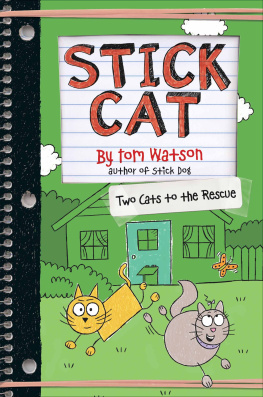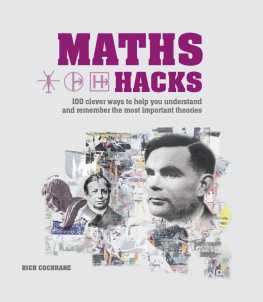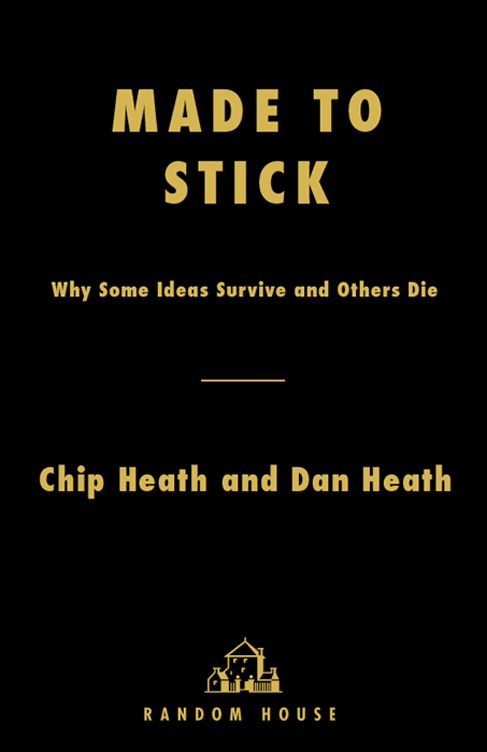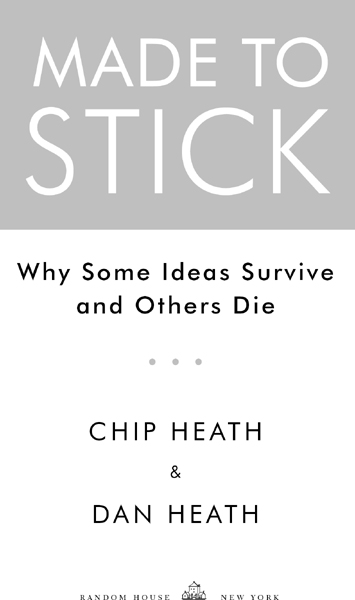To Dad, for driving an old tan Chevette
while putting us through college.
To Mom, for making us breakfast
every day for eighteen years. Each.
INTRODUCTION
Kidney heist. Movie popcorn. Sticky = understandable, memorable, and effective in changing thought or behavior. Halloween candy. Six principles: SUCCESs. The villain: Curse of Knowledge. Its hard to be a tapper. Creativity starts with templates.
CHAPTER 1
Commanders Intent. THE low-fare airline. Burying the lead and the inverted pyramid. Its the economy, stupid. Decision paralysis. Clinic: Sun exposure. Names, names, and names. Simple = core + compact. Proverbs. The Palm Pilot wood block. Using whats there. The pomelo schema. High concept: Jaws on a spaceship. Generative analogies: Disneys cast members.
CHAPTER 2
The successful flight safety announcement. The surprise brow. Gimmicky surprise and postdictability. Breaking the guessing machine. The Nordie who No school next Thursday. Clinic: Too much on foreign aid? Saturns rings. Movie turning points. Gap theory of curiosity. Clinic: Fund-raising. Priming the gap: NCAA football. Pocketable radio. Man on the moon.
CHAPTER 3
Sour grapes. Landscapes as eco-celebrities. Teaching subtraction with less abstraction. Soap-opera accounting. Velcro theory of memory. Brown eyes, blue eyes. Engineers vs. manufacturers. The Ferraris go to Disney World. White things. The leather computer. Clinic: Oral rehydration therapy. Hamburger Helper and Saddleback Sam.
CHAPTER 4
The Nobel-winning scientist no one believed. Flesh-eating bananas. Authority and antiauthority. Pam Laffin, smoker. Powerful details. Jurors and the Darth Vader toothbrush. The dancing seventy-three year old. Statistics: Nuclear warheads as BBs. The human-scale principle. Officemates as a soccer team. Clinic: Shark attack hysteria. The Sinatra Test. Transporting Bollywood movies. Edible fabric. Wheres the beef? Testable credentials. The Emotional Tank. Clinic: Our flawed intuition. NBA rookie camp.
CHAPTER 5
The Mother Teresa principle: If I look at the one, I will act. Beating smoking with the Truth. Semantic stretch and why unique isnt unique. Reclaiming sportsmanship. Schlocky but masterful mail-order ads. WIIFY. Cable television in Tempe. Avoiding Maslows basement. Dining in Iraq. The popcorn popper and political science. Clinic: Why study algebra? Dont mess with Texas. Who cares about duo piano? Creating empathy.
CHAPTER 6
The day the heart monitor lied. Shop talk at Xerox. Helpful and unhelpful visualizations. Stories as flight simulators. Clinic: Dealing with problem students. Jared, the 425-pound fast-food dieter. Spotting inspiring stories. The Challenge Plot. The Connection Plot. The Creativity Plot. Springboard stories at the World Bank: A health worker in Zambia. How to make presenters angry with stories.
EPILOGUE
Nice guys finish last. Elementary, my dear Watson. The power of spotting. Curse of Knowledge again. Pay attention, understand, believe, care, and act. Sticky problems: symptoms and solutions. John F. Kennedy versus Floyd Lee.
TALKING STRATEGY. Craniums CHIFF. Inert strategies. Costcos salmon stories. Avoiding decision paralysis. Muckers. Australian bank: We sure as hell dont want to be third.
TEACHING THAT STICKS. Mugs as variables. The San Diego Zoos food-stealing pony. Teaching functions with crickets. Using emotion: Students as Civil War surgeons. Dissolving eyeballs. Rubber duckies that circled the world.
UNSTICKING AN IDEA. Wedge-drivers in World War II. Fight sticky with stickier. The Goodtimes Virus parody. How auto reliability races convinced people to sit on an explosion.

WHAT STICKS?
A friend of a friend of ours is a frequent business traveler. Lets call him Dave. Dave was recently in Atlantic City for an important meeting with clients. Afterward, he had some time to kill before his flight, so he went to a local bar for a drink.
Hed just finished one drink when an attractive woman approached and asked if she could buy him another. He was surprised but flattered. Sure, he said. The woman walked to the bar and brought back two more drinksone for her and one for him. He thanked her and took a sip. And that was the last thing he remembered.
Rather, that was the last thing he remembered until he woke up, disoriented, lying in a hotel bathtub, his body submerged in ice.
He looked around frantically, trying to figure out where he was and how he got there. Then he spotted the note:
DONT MOVE. CALL 911 .
A cell phone rested on a small table beside the bathtub. He picked it up and called 911, his fingers numb and clumsy from the ice. The operator seemed oddly familiar with his situation. She said, Sir, I want you to reach behind you, slowly and carefully. Is there a tube protruding from your lower back?
Anxious, he felt around behind him. Sure enough, there was a tube.
The operator said, Sir, dont panic, but one of your kidneys has been harvested. Theres a ring of organ thieves operating in this city, and they got to you. Paramedics are on their way. Dont move until they arrive.
Y ouve just read one of the most successful urban legends of the past fifteen years. The first clue is the classic urban-legend opening: A friend of a friend Have you ever noticed that our friends friends have much more interesting lives than our friends themselves?
Youve probably heard the Kidney Heist tale before. There are hundreds of versions in circulation, and all of them share a core of three elements: (1) the drugged drink, (2) the ice-filled bathtub, and (3) the kidney-theft punch line. One version features a married man who receives the drugged drink from a prostitute he has invited to his room in Las Vegas. Its a morality play with kidneys.
Imagine that you closed the book right now, took an hourlong break, then called a friend and told the story, without rereading it. Chances are you could tell it almost perfectly. You might forget that the traveler was in Atlantic City for an important meeting with clientswho cares about that? But youd remember all the important stuff.
The Kidney Heist is a story that sticks. We understand it, we remember it, and we can retell it later. And if we believe its true, it might change our behavior permanentlyat least in terms of accepting drinks from attractive strangers.
Contrast the Kidney Heist story with this passage, drawn from a paper distributed by a nonprofit organization. Comprehensive community building naturally lends itself to a return-on-investment rationale that can be modeled, drawing on existing practice, it begins, going on to argue that [a] factor constraining the flow of resources to CCIs is that funders must often resort to targeting or categorical requirements in grant making to ensure accountability.
Imagine that you closed the book right now and took an hourlong break. In fact, dont even take a break; just call up a friend and retell that passage without rereading it. Good luck.













